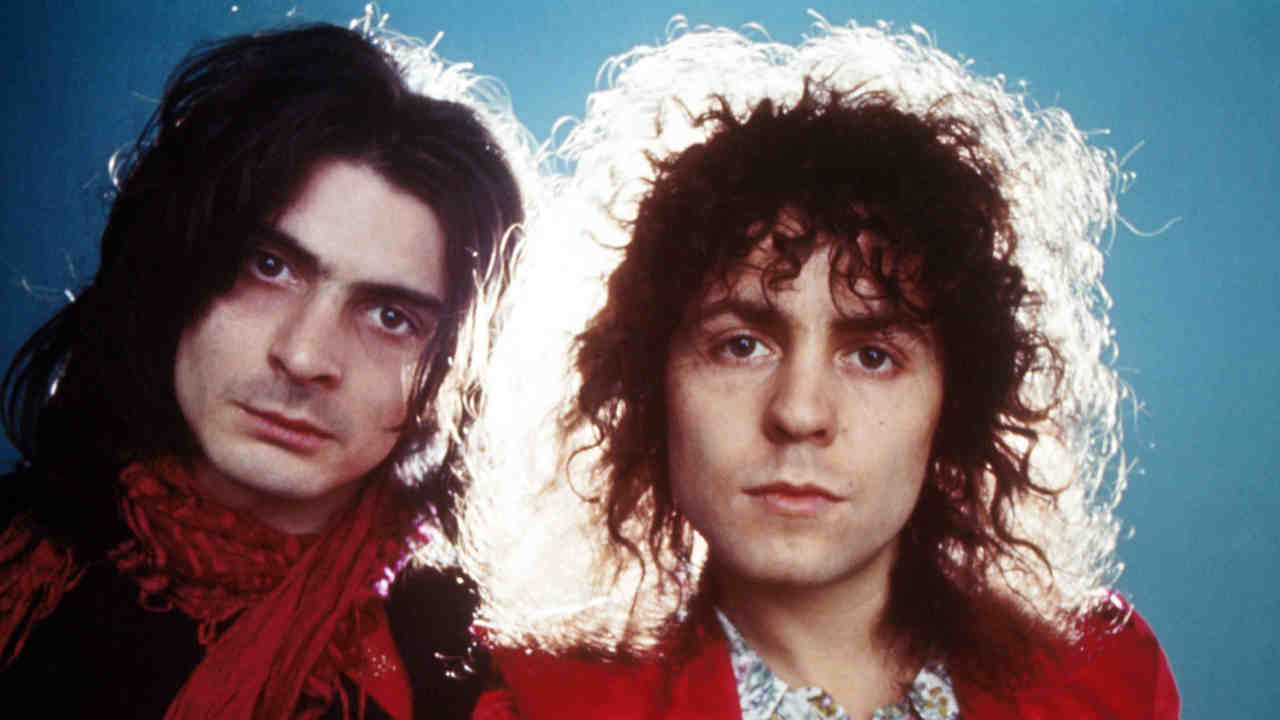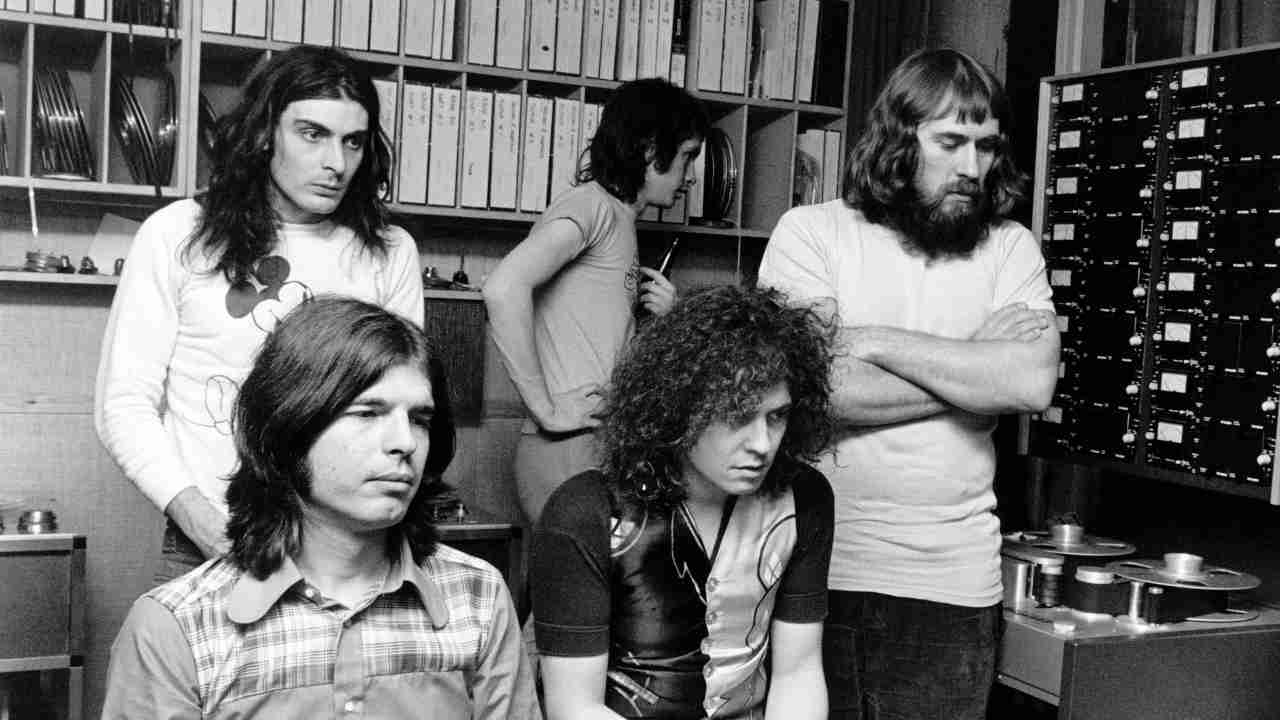
Alongside David Bowie, T.Rex were the trailblazers for the glam rock movement that dominated the UK for a few years in their early 70s. The duo of frontman Marc Bolan and percussionist Mickey Finn, had already hit big with 1971’s Electric Warrior album, but suddenly the heart was on to deliver a successful follow-up. With Bolan anxious and drinking heavily, the band hit the studio to record the album that would become 1972’s The Slider, a record that would inspire everyone from Guns N Roses to U2…

It’s spring 1972 and Marc Bolan, the rest of T.Rex and producer Tony Visconti – who tells this story – are in a limo travelling from Orly airport to the 18th-century Château d’Hérouville (recently kitted out as a residential studio facility) close to Paris for a crucial recording session. Bolan is swigging liberally from a bottle of Courvoisier and waywardly improvising a blues song. ‘I’m an old bulldog,’ he repeats, not getting any further with the lyrics. He tries to cajoles everybody to join in, but they’re not in the mood. They shuffle awkwardly and find something out of the window to pretend to look at.
“Everybody sing ‘I’m an old bulldog!’” Bolan exhorts. “Come on, you c**ts!” Eventually percussionist Mickey Finn acquiesces. The others are too irritated and demoralised to comply.
Upon arrival at the Château, at first things don’t improve. Bolan wants “the star’s bedroom”, failing to grasp that that’s the owner’s room. At the dining table he hurries the band along, telling them he’s not paying them to eat, he’s paying them to make a record. As they’re still on £75 a week and Visconti’s royalty has recently been halved, the camp is not a happy one.
“Marc had started to drink,” Visconti recalls. “He became quite intimidating towards the band. It reached the point where they were almost frightened to look into his eyes. A kind of weirdness descended upon us. I sometimes felt I was ready to leave at any moment. He didn’t turn on me… and wisely so. So I stayed. But he had a very short temper then. Electric Warrior [T.Rex’s 1971 album] had been so great – we’d been happy-go-lucky. And we were so grateful that we’d had Hot Love and Get It On both at number one for weeks on end. The spirit was absolutely great. But now it got… strange.”
Yet from these inauspicious beginnings, the subsequent sessions, at which the bulk of the new album they were working on was recorded, resulted in one of the Mount Rushmore landmarks of popular rock.
“Y’know, good things happened and bad things happened,” Visconti says philosophically. “By the end we’d had a great time, really. Whatever that pressure on Marc was, it created one of the best T.Rex albums of all. I really have huge fondness and affection for it. Great songs, some great sonic tricks. You listen to that album and Marc Bolan truly was… ingenious.”

Released in July ’72, The Slider strode in on the back of Telegram Sam and Metal Guru, two of the most vibrant sparks of impishness the Top Of The Pops chart has ever known. Disappointingly, however, the album peaked at No.4 in the UK, just scraping into the Top 20 in the US. As a result, Bolan, with his patented blend of braggadocio and insecurity, was scared that the supernova status he’d attained – after all the years of wild mutations as a folkie, a mod and then going electric – might be slipping away as quickly as it had come. He told the NME at the time: “What people do with you in their own minds you can’t stop… but I’d be very upset if the press wrote me off as anything less than a musician and a poet. If there’s going to be any kind of revolution in music, it must come from young people. If you ignore them, you’re cutting yourself off from the life force. With The Slider we must have convinced a few people who criticise me for producing ‘samey’ singles that we have some extra dimensions.”
To a teenage fan discovering the sexy, motivational joy of music, these records were indeed a revolution in the head. T.Rex had sold 16 million records in less than a year and a half – around four per cent of all singles sold in the UK during that period were theirs. No-square, corkscrew-hair, natural-born star Bolan, along with his pal/rival David Bowie, had, as far as those of us in the schoolyard were concerned, blown away old 60s relics such as the Stones, Dylan and The Beatles forever. Surely they’d never come back from this all-conquering, other‑worldly thunder-crack of racy riffs and mad poetry.
Tony Visconti has been a key element in the room for some of the most significant moments in rock’s lifetime, from the Tyrannosaurus Rex albums, through Bowie’s golden years, via digressions with Thin Lizzy, Sparks, Iggy, the Stranglers, Adam Ant, Manic Street Preachers et al, right through to Bowie’s magnificent Blackstar swansong. Taking a break from being busy in an LA studio, he casts his mind back to late ’71/early ’72 and muses that it was “a strange point in Marc’s career”.
The breakthrough success of Electric Warrior meant that when its sales finally began to slow, “we felt we needed to fill the void. Or Marc did. He had this anxiety to make a new album immediately. So he was drinking heavily, worried about the finances. We had only four days booked, but if my memory serves me well, we recorded seventeen songs in those days. We were working pretty much from the minute we woke up to very late at night, every day.”
Was Bolan unsettled by the sudden and massive rush of T.Rextasy? Wasn’t that what he’d been craving for years?
“Yeah, but he felt this imposition of having to come up with another hit album. And fame fuelled that fire. Hot Love and Get It On had been so very big everywhere. After that kind of elation, y’know, there’s always… a hole. Even I had a feeling of that. We really felt we had a job to do. It had to be every bit as good. And I think it was. We accomplished that. The Slider is acknowledged as one of his greatest.”
The album’s calling cards roared in with irresistible swaggers of confidence – the correct use of ego. Telegram Sam and Metal Guru project successful, strutting bravado. They’re established as tablets from Moses now, but at the time seemed alien, daring and counter-intuitive. That fusion of stomping rock grooves, grandiose strings and stratosphere-high backing vocals brought a new dimension to music.
On The Slider, Bolan also confirmed that he could drive hard (Buick MacKane, which Guns N’ Roses covered; Chariot Choogle) and deliver dreamy, trippy, self-referencing mooches (Spaceball Ricochet, the Lennon and Dylan namechecking Ballrooms Of Mars).
Visconti shares that Bolan, prone to singing about black cats, had developed a superstition or two. “Strings were a superstition for Marc. After he’d realised his first two hits had strings on, I asked if he was aware I hadn’t put any on Get It On. And he paled. He urged me to write something on the spot, which I did. So I don’t think you’ll find a heyday T.Rex single without strings on it. Even Jeepster: okay, it didn’t have violins, but it had cellos. And a bassoon, I might add.
“I mean, Metal Guru was just crazy good. A kitchen-sink mix, I remember. By which I mean very, very difficult to mix. Because another superstition Marc had was that we had to have two guys singing in falsetto. That was, of course, Flo & Eddie [Mark Volman and Howard Kaylan, former Turtles and Mothers Of Invention], who’d come into our lives on a song called Seagull Woman on the T.Rex album of 1970. Marc always had to have them on board. So by this time, all these external sources – the strings, their voices – were a key part of the T.Rex sound. Which of course proved problematic when Marc went on tour with just the four-piece band.”
Live, T.Rex were a different entity. More raw and rough-edged, sure, but hardly lacking fireworks, as the contemporaneous T.Rex documentary film Born To Boogie captured. Ringo Starr famously directed that, and today Visconti chuckles as he acknowledges an old debate. I ask if he stands by his claim in his autobiography that it was he – not Ringo – who took the iconic cover photos of a top-hatted Bolan on the sleeve of The Slider.
“I certainly did! We’d had long breaks while shooting Born To Boogie while Ringo set up different scenes, so Marc gave me his Nikon F camera and we walked out into the woods and I shot three rolls of film. So back in London I’m at Marc’s flat and I see the contact sheets and say: “Oh, those are all the ones I took.” He had a funny look on his face, and goes: “Oh, right. Well, initial the sheets and if I ever use them, I’ll give you a credit.” Of course, three months later he conveniently forgot and credited them to Ringo. I mean, this is my recollection of how things went down. If Ringo wants to challenge me on it, he’s welcome.”
Kind reviews for The Slider did not come as easily as Bolan had hoped. “Startlingly bad by any conventional critical standards,” grumbled Charles Shaar Murray in the NME. He continued: “Dangerously close to a total artistic collapse… a colossal drag. Here, Marc is just not trying.” He even panned Visconti’s “mediocre” strings and production.
Richard Williams in The Times was less cruel. Praising Visconti, he observed that “The Slider is… wondrous to behold. The hushed intimacy of Bolan’s vocal delivery helps to make one word do the work of ten, particularly when combined with his gift of coining oddly appealing images.”
The New York Times said: “Mr. Bolan has a certain fey charm that in the end defies analysis.”

Visconti recalls that the happiest moments were late-night parties at the Château d’Hérouville, when “the French wine would kick in and we’d listen to the playback of the songs we’d done that day. We’d run around the building, having a ball. That was the fun part. It was worth all the stress to hear that these tracks were… scintillating.”
Bolan’s gusto meant the band rarely knew what they were playing until he opened up his book of lyrics and started a new song. Drummer Bill Legend felt frustrated that he’d just be finding his way around one when Bolan would shoo the band on to the next. But as Visconti suggests: “At night you’d listen back and not care about any loose ‘mistakes’, because you’d hear something so fresh and alive. Even to me that’s more important.”
And the feel, he agrees, was fostered because Legend and bassist Steve Currie were a heaven-sent rhythm section for Bolan. “Oh yeah. Fabulous musicians, those guys. Deeply underrated.”
Whether it was a nervous reaction to the sniffy reviews and the album’s failure to make No.1 or a fevered rush of creative energy, Bolan hauled T.Rex back to the Château later that year to record another, which became Tanx, released in January ’73.
A typically garrulous Bolan had told journalist Keith Altham: “All I really want to be is myself. All the lunacy and merchandising going on around me are nothing to do with me – I mean, Bolan pillows? Please, people! Sometimes I feel all these things are something I’m meant to go through in some weird, fatalistic way. I honestly feel it could all end tomorrow. Not just the band thing – I mean life. But what will be will be. People tell me to take a holiday because I’m going to kill myself. But I just can’t, I can’t.”
Perhaps revealing that cosmic subconscious awareness of mortality, between tours Bolan was recording with such prolific inspiration that he could leave off Tanx the classic singles Children Of The Revolution, Solid Gold Easy Action and 20th Century Boy. Visconti cites Bolan’s genuine consideration for his fans: he didn’t like them “paying twice” for hits, and he habitually released three-track “maxi-singles”.
A musical departure, the album embraced twisted elements of soul, funk and gospel. Ironically, the press cliché that T.Rex records were “samey” just kept droning on, missing the point. American reviews were more alert, however, with Creem saying “song for song, Bolan’s strongest album”. For the first time, they used female backing vocalists (Visconti reckons Flo & Eddie left because they weren’t getting paid), and a Mellotron and saxophones infiltrated the T.Rex sound. Tracks such as the wistful Electric Slim And The Factory Hen and frank ballad Broken Hearted Blues moved into new emotional pastures. Tanx jumps from style to style, but what confused listeners then is what makes it still magical today.
The mood at the Château was better this time. “More relaxed,” says Visconti. “I remember that little French girl, the record label guy’s daughter, saying: ‘Donna la Folle… par T.Rex,’ at the start of Mad Donna, in her beautiful accent. And I enjoyed messing about with the Mellotron – that’s me warming up at the start of Tenement Lady. Thing is, most British artists at the time, including David Bowie, were in love with soul and funk music – Funkadelic, all that. So Marc had this interest in sounding more ‘cool’, more hip, y’know? He certainly had the rhythm in him; he knew that genre well. Gloria Jones [American singer-songwriter, soon to be Bolan’s girlfriend] hadn’t entered the scene yet. She was there for the next one, Zinc Alloy. But he was heading in that direction, for sure.”
Tanx’s epic finale, Left Hand Luke And The Beggar Boys, bends the shapes of gospel to Bolan’s will. It was influenced by Montague The Magnificent, an eponymous 60s single by a New York R&B DJ who ‘rapped’, or sermonised, over melodramatic backing.
“Yeah, he loved that,” Visconti reminisces fondly. “I’d made a copy of it for him. He and Bowie used to come back to my flat in Earls Court and I’d play all my American soul records to them. We used to play that track over and over. (It’s worth noting that Tanx was released two years before Bowie’s Young Americans.)
Bolan was still mean with giving credits, though. “He said: ‘I’m not going to give you credit for string arrangements, playing guitar, bass… because then your name would appear more than mine on the sleeve,” Visconti remembers.
None of these character flaws alter the fact that Tanx is another jewel. Visconti, its producer, who would return to the Château d’Hérouville to make further history with Bowie, is keen to stress that Bolan’s lyrics “were always so colourful and imaginative. He was one of the best lyricists I ever worked with. And the way he’d set them across a backing… he really got the balance right. His songs were both catchy and brilliant. Even though it’s inaccurate, I always think of Electric Warrior, The Slider and Tanx as the first three albums, and they’re timeless classics.
“You hear stuff on the radio now that sounds like them because people are recording a little more minimally again. I think every good rock band has the spirit of T.Rex in their DNA. Every one. You can hear it from Guns N’ Roses to U2 to Foo Fighters. They all have a touch of T.Rex.
“Marc wrote the primer for how to make a great rock’n’roll track. And co-created glam rock too. I’m so proud of everything I did with him. He just did everything right in this period. Kids will still be playing and loving these records long after we’re all gone. They’ll survive.”
Originally published in Classic Rock issue 241







